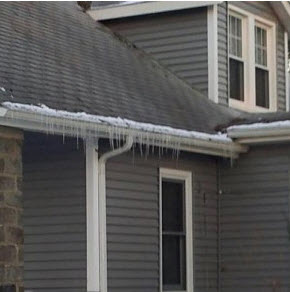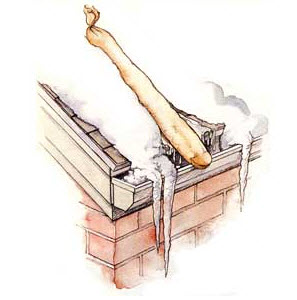What are ice dams?
ICE DAMS IN 30 SECONDS – WATCH!Watch for 30 second and understand how these monsters form. It'll help you understand how to prevent them as well. Knowledge is power.
Posted by Kevin O'Connor on Wednesday, January 20, 2016

Ice dams occur after a snowfall – even 1 or 2 inches – and several days of freezing temperatures. Warm air inside your home or business leaks into the attic and warms the roof causing snow and ice on the roof to melt. The melted water then drains along the roof, under the snow, until it reaches the cold overhang. The overhang is usually the same temperature as outdoors and the melted water refreezes and forms an ice dam.
Contrary to popular belief, gutters don’t cause ice dams. But, gutters can concentrate ice and water in the eaves. When gutters fill with ice, they can bend and rip away from the house bringing fascia, fasteners and downspouts along with them.

What’s the first sign of an ice dam?
Icicles!
I know, I hear you thinking “But icicles are so pretty! Why should I care if I see them?
Believe it or not, ice dams cause millions of dollars of damage every year. Sometimes the damage is visible: dislodged roof shingles, sagging ice-filled gutters outside, and water-stained ceilings, peeling paint, and damaged plaster inside. These are all easy to see and can be repaired when weather and budgets permit. But other damage is not as obvious and can cause health consequences even months after winter is just a memory.
Water damage from ice dams soaks attic insulation. Water-soaked insulation gets compressed so that even after it dries, the insulation in the ceiling isn’t as thick, which causes more lost heat. As a result, you’ll end up paying more to heat and cool your home or business. But even more than increased heating and cooling costs, the undetected water damage from ice dams can be hazardous to your health!
Water from ice dams can leak into the wall frame where it wets wall insulation. This moisture gets trapped within the wall cavity. The result: smelly, rotting wall cavities – and an ideal area for mold and bacteria to grow. Bacteria, mold and mildew then get circulated throughout the home or business by forced air heating systems. And then the well-being of allergy-sensitive individuals is compromised.
So, how can you prevent water damage from ice dams?
1. The trick is to keep the entire roof below freezing if possible. Venting the roof helps, as well as properly insulating, and then blocking as many air leaks as possible.
2. Make sure to shovel around downspouts so that your gutters can drain freely. This will help prevent ice buildups in gutters.
What can I do to decrease water damage from an ice dam?

A simple, temporary fix I found was suggested by the writers at “This Old House” and the Home Depot blog sites:
Fill the leg of discarded pair of panty hose with a calcium chloride ice melter. Lay the hose onto the roof so it crosses the ice dam and overhangs the gutter. If necessary, use a long-handled garden rake or hoe to push it into position. The calcium chloride will eventually melt through the snow and ice and create a channel for water to flow down into the gutters or off the roof. Calcium chloride filled ice melt socks will not damage shingles. Snow melt socks are a tried and proven method and work on sloped or flat roofs. DO NOT use rock salt because it has iron in it that can stain your roof.
Please stay safe and don’t get on the roof to attack an ice dam. You could cause even more damage to your roof, or you could slip and fall off the roof and seriously hurt yourself!
But if you discover ceiling water damage from an ice dam,
please call us at 877-750-7876 as soon as you see it!
We’re on call 7 days a week, 24 hours a day. We can get you clean, dry, and sanitized BEFORE the mold and bacteria starts to grow and causes health problems for you or those you love.

Pingback: Frozen gutters, ice dams the biggest threat to your home right now! -
Pingback: The 9 Most Common Causes of Mold Growth in Your Home -
Pingback: What To Do About Winter Weather Water Damage